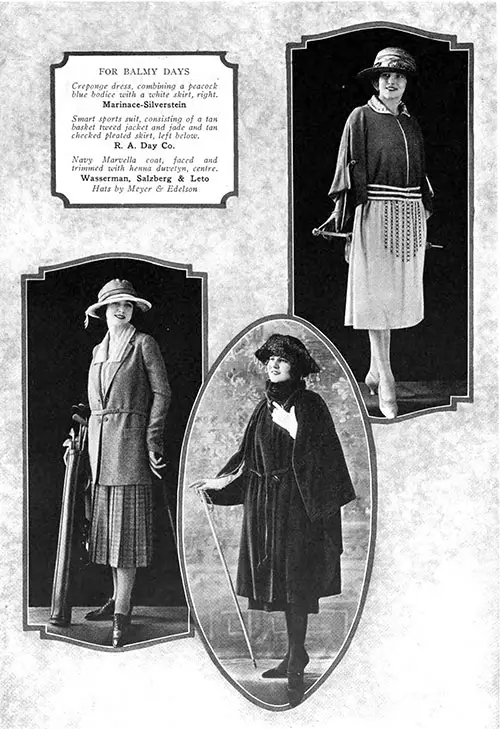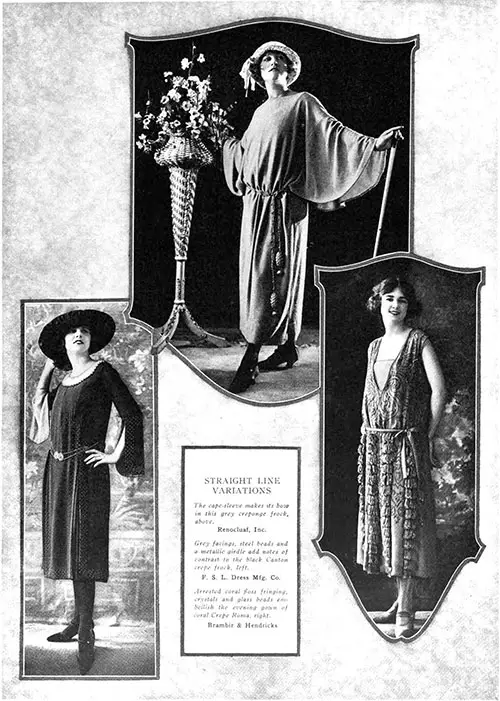Spring Dresses and Gowns - January 1922
Leading questions concerning the Winter Resorts and Spring openings indicate widespread interest in the fabric choice somewhat after this fashion.
What is the place held by crepe in both dull and lustrous weaves; what can one expect of the new sports silks; what is jersey to record; how do the fine wools work out in the cape costume developments?
Beginning with the hold-over interest in crepes, it is a matter of easy assurance that crepes, of practically all textures in good standing during the past year, are to be employed in the crepe dress entire, in its combinations with kasha and the numerous twills, with wool crepes, the deluxe flannels, and georgettes.
Plain and broché crepes form a combination in themselves, as do plain with plaid or geometric patterns.
Varying degrees of favor promote the new rib crepes, but frequently the house which offers the former for its style value retains Canton through a long and important series. Canton is especially favored in the medium price lines and is shown in excellent quality.
Crepe faille, kitten's ear crepe, crepe Elizabeth, crepe Renee and Crepe Roma are very generally adopted, in many instances approved for the morning, afternoon, and evening dress alike, with fine impartiality.
Taffeta looms up as a strong factor in black and navy. These frocks indeed constitute an essential item in the calculations for obtaining the favor of both maid and matron.
Bouffancy in large degree influences the designer of taffeta modes, the hip distension achieved by cording and fine gathers massed firmly into line above a light crinoline inset section being very generally adopted.
Again, the preference for fullest gathers into the waist belt is noted in many quarters with wide inset section of corded or tucked self-fabric which gives an extreme flare.
An artistic interpretation of this tucked section treatment was seen with the entire surface of the skirt covered by a widely branching open design in pointed leaves and stems executed in Saxe blue.
The sleeves also carried suggestions of this design while an embroidered batiste collar and gauntlet cuffs offered a distinctive and unusual finish to a picturesque type of frock.
Again the fringed ruché is interestingly applied to daytime frocks, in curving scallop formations, in diamond and cross plaid lines. When the ruché is picot-edged in silver, the effect is heightened by adding silver faced moire ribbons in self-tone or contrasting coloring.
For the neckline of these attractive features there are nets with Val lace in upstanding rows, English eyelet embroidery, shaped shallow collars in fine filet and baby Irish laces.
This type of neck finish had considerably increased during December one well-known designer presenting Oriental lace, embroidery, or unique colored motifs upon ecru net, upon practically the full showing of jeune fille frocks.

For Balmy Days: Creponge dress, combining a peacock blue bodice with a white skirt, right. from Marinace-Silverstein. Smart sports suit, consisting of a tan basket tweed jacket and jade and tan checked pleated skirt, left below. from R. A. Day Co. Navy Marvella coat, faced and trimmed with henna duvetyn, center. from Wasserman, Salzberg & Let. Hats by Meyer & Edelson
Decorative Details
The decorative influence of Paisley has increased rather than diminished as Winter merges into Spring. The recently imported Haas collection of models showed this influence as the outstanding feature of the decorative type of frock and suit, and so admirably were the details conceived by Lanvin that they were immediately purchased by one of the leading houses of creative design.
Here the sections cut from old shawls were applied with careful regard for light and dark effects. Upon a one-piece frock of tan jersey cloth, a narrow panel was inset into the front section at the bust line, dropping to the hemline.
The curving outline of the motifs was made the line of contact with the body of the dress and this, in turn, was outlined by darning stitch parallel lines of fine wools in the Paisley colorings, a highly effective detail.
As applied to deep mahogany or maroon shade of Casavan, the Paisley sections were emphasized by lines of Paisley blue with excellent results.
It is, therefore, a matter of interest to observe the uses of Paisley prints, embroideries upon Paisley colorings, piping, bandings, bordering, sleeve sections, facings and sashes, each and all recording the favor of this artistic influence.
Paisley also enters by way of rust or mahogany tones being inserted as a sleeve, blouse, and skirt section, the line of contact with black, blue or beige being traced with antique gold or silver threads.
Leather is employed, as is cire, in creating effects suggesting Paisley patterns, these also adroitly introduced upon both the fine woolens, silk crepes and Shantung in its glorified Spring edition.
A great deal of attention is paid to pattern cut work by various houses, the design showing the fabric cut away leaving the pattern usually of geometries or conventionalized florals outlined by a silk stitchery.
The novel utilization of this type of embellishment introduces it as a sharply contrasting color or fabric variation, as border set in above the hem, as bodice or sleeve section.
A particularly useful new jewel green Canton is handled with soft lines made effective by the introduction of cubes of white set in the skirt section in the ornate design below the knees and in the sleeve adding a zestful touch by conjoining a white crepe cuff and puff to the main sleeve developed in the green.
A gown of Paisley suggestion which offers many distinctive features is completed by a cape—an accompanying item of many of the crepe gowns. In this instance, the Paisley or Persian motifs are executed in decorative embroidery, practically covering the bodice section, half of the sleeve, the square cut collar and two pockets on the cape cleverly introducing motifs into the corners of the fronts.

Straight Line Variations: The cape sleeve makes its bow in this grey creponge frock, above. from Renocluaf, Inc. Grey facings, steel beads, and a metallic girdle add notes of contrast to the black Canton crepe frock, left. from F, S. L. Dress Mfg. Co. Arrested coral floss fringing, crystals and glass beads embellish the evening gown of coral Crepe Roma, right. from Brambir & Hendricks.
Sleeve Treatments
As a matter of fact, the handling of the sleeve governs in large degree the characteristics of the gown throughout the whole resorts wear and Spring line. The square is developed in innumerable forms, but it also moves into triangular lines, and there is a new circular shaping which is decidedly impressive.
This movement is along the gradual evolution adopted throughout all lines of dress today and finds an original interpretation in semi-sportswear as well as the formal dress group. It is equally effective in Salome velvet and in the new sports fabric, creponge.
A flaring semi-circular section is faced with vivid color, which reappears as panel or sash opening, and is cut in one with the bodice section or added to a straight line moving from shoulder to girdle line.
It may meet the girdle as a blouse line or move into a flat front and back silhouette. In either handling, however, it creates a fresh and up-to-the-second air for itself.
Sports Coates
Those ever increasingly charming creations of informal dress, erroneously designated sports dress, have now taken unto themselves delightful little hip jackets, which develop clever oddities in the way of sleeve treatments.
In color, these are worn over charming one-piece frocks and will strongly rival the cape and cape-wrap, each of which has become essential in the variation of the Spring fashion program.
Perhaps a perfect illustration of the interest which these lend to practical and thoroughly becoming costume developments is one of Nattier blue, presenting a cuff lower edge, an original open sleeve and a border development of ornate beads which links up the color values with the one-piece frock worn beneath.
With crepe frocks, there are finger-tip length coats which offer a new irregular panel suggestion at their lower edge. For collar, sleeve and rever embellishment there is a new version of ribbon fur and hand crocheted and handcraft ribbon loop effects.
There are also exciting bandings which present brushed silk and satin striping and many beadworks and wool embroidery elaborations.
Voile and Organdie Features
From the standpoint of both the youthful and more mature developments, the new high color voiles with their novel striping and figurations in black and color contrast strongly rival the new organdies and semi-transparent cotton crepes.
Such voile fabrics as these are developed with parallel lines of fine Val, slightly ruffled and introduced in stripe effects between lines of printed striping, or as sole embellishment upon plain tone foundations.
Ribbon girdles include wide moire sash effects, double or triple windings of narrow moire faced with lame, or in two-tone velvet effects. The floral and fruit cluster at the belt line is frequently encountered.
Metallic threads when introduced upon organdie and organdie may achieve triple striping, plaiting, borders, and any number of clever variations. When lame threads are woven into a Saxe blue voile and fine cross striping of rose are added, such fabric becomes an inspiration for a simple low-blouse frock with a bateau neckline and Saxe blue velvet and lame silver ribbons for its girdle.
“Gay and Sparkling Details Introduce Spring Dresses and Gowns: From Organdie to Kasha the Keynote of Versatility Marks Soft Line and Tailored Modes,” in The American Cloak and Suit Review: Devoted to the Women’s and Children’s Ready-to-Wear Trades, New York: John M. O’Connor & Co., Vol. XXIII, No. 1, January 1922, p. 129-131.
Note: We have edited this text to correct grammatical errors and improve word choice to clarify the article for today’s readers. Changes made are typically minor, and we often left passive text “as is.” Those who need to quote the article directly should verify any changes by reviewing the original material.
